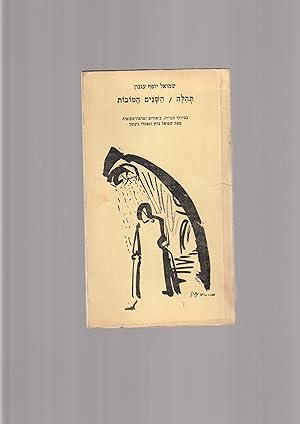agnon shmuel yosef 1887 1970 explanatory (1 Ergebnisse)
Produktart
- Alle Produktarten
- Bücher (1)
- Magazine & Zeitschriften
- Comics
- Noten
- Kunst, Grafik & Poster
- Fotografien
- Karten
-
Manuskripte &
Papierantiquitäten
Zustand
- Alle
- Neu
- Antiquarisch/Gebraucht
Einband
- alle Einbände
- Hardcover
- Softcover
Weitere Eigenschaften
- Erstausgabe
- Signiert
- Schutzumschlag
- Angebotsfoto
- Kein Print-on-Demand
Land des Verkäufers
Verkäuferbewertung
-
Tehila / Hashanim hatovot : betzeruf he'arot, beurim vemar'eh mekomot
Verlag: Schocken, Jerusalem - Tel Aviv, Israel, 1977
Anbieter: Meir Turner, New York, NY, USA
Buch
Soft cover. Zustand: Very Good. No Jacket. In Hebrew. 54 pages. 181 x 104 mm. 7 pages have lightly penciled notes in Hebrew and English that have not been erased since they can actually be useful. Minor stain in bottom of pages' inner margin. Shmuel Yosef Agnon (Shmuel Yosef Halevi Czaczkes)(Buczacz, Polish Galicia, then part of the Austro-Hungarian Empire, now Buchach, Ukraine, July 17, 1888 ? Jerusalem, February 17, 1970) was an Austro-Hungarian-born Israeli novelist, poet, and short-story writer. He was one of the central figures of modern Hebrew literature. In Hebrew, he is known by the acronym Shai Agnon. In English, his works are published under the name S. Y. Agnon. His works deal with the conflict between the traditional Jewish life and language and the modern world. They also attempt to recapture the fading traditions of the European shtetl (village). In a wider context, he also contributed to broadening the characteristic conception of the narrator's role in literature. Agnon had a distinctive linguistic style, mixing modern and rabbinic Hebrew. In 1966, he shared the Nobel Prize in Literature with the poet Nelly Sachs. His father, Shalom Mordechai Halevy, was ordained as a rabbi, but worked in the fur trade, and had many connections among the Hasidim, his mother's side had ties to the Mitnagdim. He did not attend school and was schooled by his parents. In addition to studying Jewish texts, Agnon studied writings of the Haskalah, and was also tutored in German. At the age of eight, he began to write in Hebrew and Yiddish, At the age of 15, he published his first poem, in Yiddish, about the Kabbalist Joseph della Reina. He continued to write poems and stories in Hebrew and Yiddish, which were published in Galicia. In 1908, he moved to Jaffa in Ottoman Palestine. The first story he published there was "Agunot" ("Chained Wives"), which appeared that same year in the journal Ha`omer. He used the pen name "Agnon", derived from the title of the story, which he adopted as his official surname in 1924. In 1910, "Forsaken Wives" was translated into German. In 1912, at the urging of Yosef Haim Brenner, he published a novella, "Vehaya Ha'akov Lemishor" ("The Crooked Shall Be Made Straight"). In 1913, Agnon moved to Germany, where he met Esther Marx (1889-1973), the sister of Alexander Marx. They married in 1920 and had two children. In Germany he lived in Berlin and Bad Homburg vor der Höhe (1921?24). Salman Schocken, a businessman and later also publisher, became his literary patron and freed him from financial worries. From 1931 on, his work was published by Schocken Books, and his short stories appeared regularly in the newspaper Haaretz, also owned by the Schocken family. In Germany, he continued to write short stories and collaborated with Martin Buber on an anthology of Hasidic stories. Many of his early books appeared in Buber's Jüdischer Verlag (Berlin). The mostly assimilated, secular German Jews, Buber and Franz Rosenzweig among them, considered Agnon to be a legitimate relic, being a religious man, familiar with Jewish scripture. Gershom Scholem called him "the Jews' Jew". In 1924, a fire broke out in his home, destroying his manuscripts and rare book collection. Later that year, Agnon returned to Palestine and settled with his family in the Jerusalem neighborhood of Talpiot. In 1929, his library was destroyed again during anti-Jewish riots. Agnon writes about Jewish life, but with his own unique perspective and special touch. Agnon's writing often used words and phrases that differed from what would become established modern Hebrew. His distinct language is based on traditional Jewish sources, such as the Torah and the Prophets, Midrashic literature, the Mishnah, and other Rabbinic literature. Agnon was twice awarded the Bialik Prize for literature (1934 and 1950). He was also twice awarded the Israel Prize, for literature (1954 and 1958).


